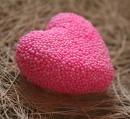
Purpose
To observe how two chemicals react to form a flexible polymer, a homemade floam!
Additional information
Floam is a flexible compound composed of micro-beads that was first introduced by Mattel in 1994 under Nickelodeon branding and was called "bubble-gak". The floam brand has since dropped the Nickelodeon branding and is now manufactured by several companies, although the "floam" title is a registered trademark of SAS Incorporated.
Floam can be a fun way to show your creative side and this project will save you some money! Create all the floam you want when you want!
Sponsored Links
Required materials
- Water
- 2 teaspoons of borax
- White all-purpose glue (Elmer's glue is recommended)
- Food coloring (red, green, and blue)
- Polystyrene beads (plastic foam beads, often what bean-bags are filled with)
- Mixing bowl
- Drinking glass
- Spoon (for mixing)
- Airtight container (to store your floam)
- Plastic zip-lock bag
Estimated Experiment Time
About 10 minutes
Step-By-Step Procedure
- 1. Add 1/2 cup of room-temperature water to the drinking glass. Add 2 teaspoons of borax to the drinking glass. Stir with a spoon until the borax dissolved.
- 2. In your mixing bowl add 1/4 cup of water. Mix-in 1/4 cup of white glue. Add your food coloring to the mixture and mix with your spoon. You can mix multiple colors or just keep to the primary color of your food coloring, it's up to you!
- 3. Pour the glue-based solution from the bowl into the plastic zip-lock bag. Add your polystyrene beads. Next pour your borax solution from the drinking glass into the zip-lock bag. Seal the bag.
- 4. Form your floam solution in the bag by "kneading" it until it's well mixed. Your floam will be ready once the borax solution has been absorbed and the mixture takes on a solid-state.
- 5. Your floam is now ready. Take your floam out of bag and shape it into anything you want!
Note
If you want a slimier, more flexible floam you can try adding less borax. Try the experiment with one teaspoon for a more flexible floam. The more borax you add, the stiffer the floam will become.
When not in use, store your floam in an air-tight container and place it in the refrigerator to prevent molding. Floam that is left outside the container and exposed to the environment will eventually dry out.
Observation
What would happen if you were to add more borax to the solution? What about less? What would happen if your floam creation was left out in the open air? What kind of fun floam creations were you able to make? Can you think of another form of this experiment that you can perform with borax for a fun result?
Result
When the borax solution is mixed with the glue solution, it stops the glue from behaving like a liquid. The borax mixes with the polyvinyl acetate molecules in the glue, forming an elastic polymer. The result is a flexible plastic-like material that can be manipulated into a variety of fun shapes!
Sponsored Links
Take a moment to visit our table of Periodic Elements page where you can get an in-depth view of all the elements,
complete with the industry first side-by-side element comparisons!